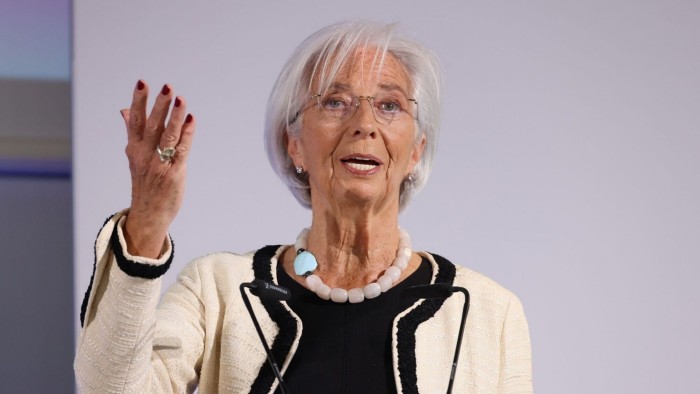Christine Lagarde says ECB will not commit to path of rate cuts

Roula Khalaf, Editor of the FT, selects her favourite stories in this weekly newsletter.
Christine Lagarde has said the European Central Bank will be unable to commit to a particular path of interest rate cuts once it starts to ease monetary policy, despite signs that wage growth has peaked in the eurozone.
The ECB president’s comments indicate that even if it starts to cut borrowing costs in June — as many investors expect after inflation fell sharply over the past year — it is likely to keep markets guessing on the timing and scale of potential rate cuts.
Lagarde told a conference of ECB watchers in Frankfurt on Wednesday that continued high wage growth and weak productivity in the eurozone meant services inflation was expected “to remain elevated for most of this year”. This meant it would need to continue checking that “incoming data supports our inflation outlook”, she said.
Earlier this month, the ECB cut its inflation forecast for this year to 2.3 per cent and predicted it would drop to its 2 per cent target in mid-2025.
“Our decisions will have to remain data dependent and meeting-by-meeting, responding to new information as it comes in,” Lagarde said. “This implies that, even after the first rate cut, we cannot pre-commit to a particular rate path. However tempting that is. However much each of you would like to see it.”

The ECB has signalled that June is the earliest it is likely to cut rates, arguing that it will only have sufficient data to know whether inflationary pressures from rising wages continued to ease in the first quarter after its next meeting in April.
Lagarde stuck to this timeline on Wednesday, saying the bank would have more information “in the coming months” that would allow it to check “whether wages are indeed growing in a way that is compatible with inflation reaching our target sustainably by mid-2025”.
She said the ECB’s inflation forecasts had become more accurate in recent months — after being much less reliable at the start of the surge in prices more than two years ago. This made it more confident that it would be able to “move to the next phase of our policy cycle” in the coming months.
Recent eurozone wage data “point in this direction”, she said, after a slowdown in the growth of negotiated wages to 4.5 per cent and pay per employee to 4.6 per cent in the fourth quarter.
The ECB’s more forward-looking wage tracker, which collates real-time data on collective wage agreements, showed average wage growth would be 4.2 per cent this year, down from a reading of 4.4 per cent in January, Lagarde said.
The central bank considers wage growth of 3 per cent to be consistent with its 2 per cent inflation target.
Eurozone inflation slowed from above 10 per cent in 2022 to 2.6 per cent in February, bringing it tantalisingly close to the ECB’s 2 per cent target. In response, some ECB governing council members have started to express their views on the pace of rate cuts.
Greek central bank governor Yannis Stournaras recently said it could cut rates twice before the summer and four times in total this year. Finland’s central bank boss Olli Rehn said that if inflation appeared to be stabilising at 2 per cent “then we will have the conditions for several interest rate cuts this year”.
However, Lagarde warned that “domestic price pressures will still be visible” for much of this year, and while the ECB forecast wage growth would slow to 3 per cent by 2026, the tightness of eurozone labour markets meant this “cannot be taken for granted”.
If wages rise faster than the ECB predicts as workers seek to regain their lost purchasing power, that could keep inflation at 3 per cent this year and 2.5 per cent next year, Lagarde warned.
If companies raised their profit margins 1 percentage point more than the ECB expected in the next three years, it would lead to inflation of 2.7 per cent this year and 2.4 per cent next year, she said.
Comments